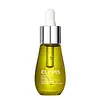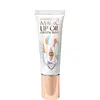What's inside
What's inside
 Key Ingredients
Key Ingredients

 Benefits
Benefits

 Concerns
Concerns

 Ingredients Side-by-side
Ingredients Side-by-side

Prunus Amygdalus Dulcis Oil
Skin ConditioningCaprylic/Capric Triglyceride
MaskingLimnanthes Alba Seed Oil
Skin ConditioningLinum Usitatissimum Seed Oil
PerfumingMacadamia Ternifolia Seed Oil
EmollientOryza Sativa Bran Oil
EmollientPapaver Orientale Seed Oil
Skin ConditioningRosa Canina Fruit Oil
EmollientSqualane
EmollientRaphanus Sativus Seed Extract
Skin ConditioningCucumis Sativus Oil
EmollientBrassica Oleracea Italica Seed Oil
EmollientParfum
MaskingLimonene
PerfumingCitrus Aurantium Dulcis Peel Oil
MaskingAmyris Balsamifera Bark Oil
MaskingCymbopogon Martini Oil
MaskingGeraniol
PerfumingLinalool
PerfumingRosmarinus Officinalis Leaf Oil
MaskingDaucus Carota Sativa Seed Oil
EmollientTocopherol
AntioxidantHelianthus Annuus Seed Oil
EmollientBenzyl Benzoate
AntimicrobialFarnesol
PerfumingCitral
PerfumingBenzyl Salicylate
PerfumingRosmarinus Officinalis Leaf Extract
AntimicrobialPrunus Amygdalus Dulcis Oil, Caprylic/Capric Triglyceride, Limnanthes Alba Seed Oil, Linum Usitatissimum Seed Oil, Macadamia Ternifolia Seed Oil, Oryza Sativa Bran Oil, Papaver Orientale Seed Oil, Rosa Canina Fruit Oil, Squalane, Raphanus Sativus Seed Extract, Cucumis Sativus Oil, Brassica Oleracea Italica Seed Oil, Parfum, Limonene, Citrus Aurantium Dulcis Peel Oil, Amyris Balsamifera Bark Oil, Cymbopogon Martini Oil, Geraniol, Linalool, Rosmarinus Officinalis Leaf Oil, Daucus Carota Sativa Seed Oil, Tocopherol, Helianthus Annuus Seed Oil, Benzyl Benzoate, Farnesol, Citral, Benzyl Salicylate, Rosmarinus Officinalis Leaf Extract
Oleic/Linoleic/Linolenic Polyglycerides
EmollientPentaerythrityl Tetraisostearate
EmollientHelianthus Annuus Seed Oil
EmollientHydrogenated Polyisobutene
EmollientCaprylic/Capric Triglyceride
MaskingTriethyl Citrate
MaskingIsopropyl Myristate
EmollientIsopropyl Palmitate
EmollientCamellia Oleifera Seed Oil
Skin ConditioningButyrospermum Parkii Oil
EmollientEthyl Vanillin
MaskingOenothera Biennis Oil
EmollientMyrothamnus Flabellifolia Leaf Extract
EmollientGlycerin
HumectantSilica Dimethyl Silylate
EmollientC10-18 Triglycerides
EmollientLecithin
EmollientSchisandra Chinensis Fruit Extract
Skin ConditioningButylene/Ethylene/Styrene Copolymer
Ethylene/Propylene/Styrene Copolymer
Sodium Hyaluronate
HumectantPlumeria Alba Flower Extract
Skin ConditioningPlumeria Rubra Flower Extract
Skin ConditioningRosa Canina Fruit Oil
EmollientTriolein
Skin ConditioningAloe Barbadensis Leaf Extract
EmollientSaussurea Involucrata Callus Extract
AntioxidantTocopheryl Acetate
AntioxidantAmethyst Powder
AbrasiveMoonstone Powder
Skin ConditioningQuartz Powder
AbrasiveRuby Powder
Skin ConditioningWater
Skin ConditioningCitrus Limon Peel Oil
MaskingSwertia Chirata Extract
HumectantGlyceryl Dioleate
EmollientTocopherol
AntioxidantRhododendron Ferrugineum Extract
MaskingSolanum Tuberosum Pulp Extract
SmoothingBHT
AntioxidantAscorbyl Palmitate
AntioxidantTetrahexyldecyl Ascorbate
AntioxidantCitric Acid
BufferingLimonene
PerfumingCitral
PerfumingLinalool
PerfumingOleic/Linoleic/Linolenic Polyglycerides, Pentaerythrityl Tetraisostearate, Helianthus Annuus Seed Oil, Hydrogenated Polyisobutene, Caprylic/Capric Triglyceride, Triethyl Citrate, Isopropyl Myristate, Isopropyl Palmitate, Camellia Oleifera Seed Oil, Butyrospermum Parkii Oil, Ethyl Vanillin, Oenothera Biennis Oil, Myrothamnus Flabellifolia Leaf Extract, Glycerin, Silica Dimethyl Silylate, C10-18 Triglycerides, Lecithin, Schisandra Chinensis Fruit Extract, Butylene/Ethylene/Styrene Copolymer, Ethylene/Propylene/Styrene Copolymer, Sodium Hyaluronate, Plumeria Alba Flower Extract, Plumeria Rubra Flower Extract, Rosa Canina Fruit Oil, Triolein, Aloe Barbadensis Leaf Extract, Saussurea Involucrata Callus Extract, Tocopheryl Acetate, Amethyst Powder, Moonstone Powder, Quartz Powder, Ruby Powder, Water, Citrus Limon Peel Oil, Swertia Chirata Extract, Glyceryl Dioleate, Tocopherol, Rhododendron Ferrugineum Extract, Solanum Tuberosum Pulp Extract, BHT, Ascorbyl Palmitate, Tetrahexyldecyl Ascorbate, Citric Acid, Limonene, Citral, Linalool
 Reviews
Reviews

Ingredients Explained
These ingredients are found in both products.
Ingredients higher up in an ingredient list are typically present in a larger amount.
This ingredient is an emollient, solvent, and texture enhancer. It is considered a skin-softener by helping the skin prevent moisture loss.
It helps thicken a product's formula and makes it easier to spread by dissolving clumping compounds.
Caprylic Triglyceride is made by combining glycerin with coconut oil, forming a clear liquid.
While there is an assumption Caprylic Triglyceride can clog pores due to it being derived from coconut oil, there is no research supporting this.
Learn more about Caprylic/Capric TriglycerideCitral is a fragrance and used to add a lemon-like scent to products. It is both naturally found in plants and created synthetically. In plants, it is commonly occurring in lemon myrtle, lemongrass, lemon tea-tree, lemon verbena, and other citruses.
The EU mandates Citral be listed separately as a fragrance. It is a known allergen and may cause contact dermatitis. Citral can also used as a masking ingredient.
The term 'fragrance' is not regulated in many countries. In many cases, it is up to the brand to define this term. For instance, many brands choose to label themselves as "fragrance-free" because they are not using synthetic fragrances. However, their products may still contain ingredients such as essential oils that are considered a fragrance.
The term 'citral' is a collective term for two geometric isomers: geranial/Citral A and neral/Citral B.
Learn more about CitralHelianthus Annuus Seed Oil is the oil derived from the seeds of a Sunflower. Sunflower seed oil is non-fragrant. It is an emollient, meaning it helps to soften the skin.
Sunflower seed oil contains many fatty acids. The fatty acids found in sunflower seeds include (from highest amount to least): linoleic acid, myristic acid, palmitic acid, stearic acid, arachidic acid, oleic acid, and linolenic acid.
These fatty acids help the skin create ceramides. Ceramides play a role in repairing the skin barrier.
Helianthus Annuus Seed Oil helps moisturize the skin. This in turn helps the skin look more rejuvenated and smoother.
Sunflowers are rich in vitamin E.
Historians believe Indigenous cultures of North America domesticated sunflowers before corn. Thus they relied on sunflower oil for a variety of uses. One such use is moisturizing skin and hair.
Sunflower seed oil may not be fungal acne safe. We recommend speaking with a professional if you have any concerns.
Learn more about Helianthus Annuus Seed OilLimonene is a fragrance that adds scent and taste to a formulation.
It's found in the peel oil of citrus fruits and other plants such as lavender and eucalyptus. The scent of limonene is generally described as "sweet citrus".
Limonene acts as an antioxidant, meaning it helps neutralize free radicals.
When exposed to air, oxidized limonene may sensitize the skin. Because of this, limonene is often avoided by people with sensitive skin.
The term 'fragrance' is not regulated in many countries. In many cases, it is up to the brand to define this term. For instance, many brands choose to label themselves as "fragrance-free" because they are not using synthetic fragrances. However, their products may still contain ingredients such as essential oils that are considered a fragrance.
Learn more about LimoneneLinalool is a fragrance and helps add scent to products. It's derived from common plants such as cinnamon, mint, citrus, and lavender.
Like Limonene, this ingredient oxidizes when exposed to air. Oxidized linalool can cause allergies and skin sensitivity.
This ingredient has a scent that is floral, spicy tropical, and citrus-like.
Learn more about LinaloolRosehip Oil is a non-fragrant plant oil. Rosehips are a fruit from a rose bush and are edible. This oil has skin conditioning and hydrating properties.
Rosehip contains Vitamin C, Vitamin E, fatty acids and linolenic acids. These nourish your skin barrier. Having hydrated skin may help reduce the appearance of fine-lines and wrinkles.
Another great component of Rosehip Oil is Vitamin A, or retinol. Vitamin A encourages your skin to create more collagen.
Rosehip oil may help with reducing pigmentation. The lycopene and beta-carotene have skin-lightening properties. However, more studies are needed to confirm this.
Learn more about Rosa Canina Fruit OilTocopherol (also known as Vitamin E) is a common antioxidant used to help protect the skin from free-radicals and strengthen the skin barrier. It's also fat soluble - this means our skin is great at absorbing it.
Vitamin E also helps keep your natural skin lipids healthy. Your lipid skin barrier naturally consists of lipids, ceramides, and fatty acids. Vitamin E offers extra protection for your skin’s lipid barrier, keeping your skin healthy and nourished.
Another benefit is a bit of UV protection. Vitamin E helps reduce the damage caused by UVB rays. (It should not replace your sunscreen). Combining it with Vitamin C can decrease sunburned cells and hyperpigmentation after UV exposure.
You might have noticed Vitamin E + C often paired together. This is because it is great at stabilizing Vitamin C. Using the two together helps increase the effectiveness of both ingredients.
There are often claims that Vitamin E can reduce/prevent scarring, but these claims haven't been confirmed by scientific research.
Learn more about Tocopherol